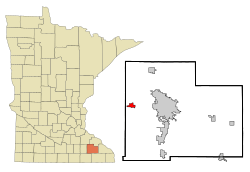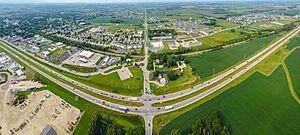Byron, Minnesota facts for kids
Quick facts for kids
Byron
|
|
|---|---|
| Motto(s):
"Where Neighbors Become Family"
|
|

Location of Byron, Minnesota
|
|
| Country | United States |
| State | Minnesota |
| County | Olmsted |
| Incorporated | 1873 |
| Area | |
| • Total | 3.04 sq mi (7.87 km2) |
| • Land | 3.04 sq mi (7.87 km2) |
| • Water | 0.00 sq mi (0.00 km2) |
| Elevation | 1,188 ft (362 m) |
| Population
(2020)
|
|
| • Total | 6,312 |
| • Density | 2,077.00/sq mi (801.99/km2) |
| Time zone | UTC-6 (Central (CST)) |
| • Summer (DST) | UTC-5 (CDT) |
| ZIP code |
55920
|
| Area code(s) | 507 |
| FIPS code | 27-09154 |
| GNIS feature ID | 2393488 |
| Website | [1] |
Byron is a city in Olmsted County, Minnesota, United States. It is about 5 miles (8 km) west of Rochester along U.S. Route 14. The city is surrounded by Kalmar Township. In 2020, the population of Byron was 6,312 people.
The main jobs in Byron are in farm services and printing. You'll see a grain elevator next to the train tracks, which belongs to the Dakota, Minnesota and Eastern Railroad. Schmidt Printing, a big company, is also located here. Many people who live in Byron also work in nearby Rochester.
Contents
Byron's Past: A Look at History
Byron was officially planned out in 1864. A post office opened in Byron in 1868. The town was named by George W. Van Dusen, after his hometown of Byron, New York. Byron became an official city in 1873. Before Byron was built, a small community called Bear Grove was located west of where Byron is now.
Where is Byron? Geography and Climate
Byron covers a total area of about 2.91 square miles (7.54 square kilometers). All of this area is land.
Byron's Weather: Climate Overview
Byron has a changing climate with warm summers and cold winters. Here's a quick look at the weather:
| Climate data for Byron 4N, Minnesota (1991–2020 normals, extremes 1993–2018) | |||||||||||||
|---|---|---|---|---|---|---|---|---|---|---|---|---|---|
| Month | Jan | Feb | Mar | Apr | May | Jun | Jul | Aug | Sep | Oct | Nov | Dec | Year |
| Record high °F (°C) | 55 (13) |
61 (16) |
80 (27) |
89 (32) |
96 (36) |
97 (36) |
103 (39) |
97 (36) |
92 (33) |
93 (34) |
77 (25) |
65 (18) |
103 (39) |
| Mean daily maximum °F (°C) | 22.6 (−5.2) |
27.4 (−2.6) |
40.2 (4.6) |
55.0 (12.8) |
67.6 (19.8) |
77.9 (25.5) |
81.2 (27.3) |
79.1 (26.2) |
72.0 (22.2) |
58.2 (14.6) |
41.9 (5.5) |
28.3 (−2.1) |
54.3 (12.4) |
| Daily mean °F (°C) | 13.0 (−10.6) |
16.8 (−8.4) |
30.0 (−1.1) |
43.3 (6.3) |
55.7 (13.2) |
66.2 (19.0) |
69.7 (20.9) |
67.2 (19.6) |
59.4 (15.2) |
45.9 (7.7) |
32.3 (0.2) |
19.7 (−6.8) |
43.3 (6.3) |
| Mean daily minimum °F (°C) | 3.5 (−15.8) |
6.1 (−14.4) |
19.7 (−6.8) |
31.5 (−0.3) |
43.8 (6.6) |
54.5 (12.5) |
58.1 (14.5) |
55.3 (12.9) |
46.8 (8.2) |
33.5 (0.8) |
22.8 (−5.1) |
11.1 (−11.6) |
32.2 (0.1) |
| Record low °F (°C) | −36 (−38) |
−40 (−40) |
−26 (−32) |
7 (−14) |
20 (−7) |
32 (0) |
40 (4) |
33 (1) |
24 (−4) |
12 (−11) |
−11 (−24) |
−26 (−32) |
−40 (−40) |
| Average precipitation inches (mm) | 1.02 (26) |
1.12 (28) |
2.09 (53) |
3.62 (92) |
4.31 (109) |
5.27 (134) |
4.63 (118) |
4.80 (122) |
3.47 (88) |
2.44 (62) |
1.90 (48) |
1.32 (34) |
35.99 (914) |
| Average snowfall inches (cm) | 8.8 (22) |
9.6 (24) |
8.8 (22) |
1.2 (3.0) |
0.6 (1.5) |
0.0 (0.0) |
0.0 (0.0) |
0.0 (0.0) |
0.0 (0.0) |
0.1 (0.25) |
2.8 (7.1) |
12.5 (32) |
44.4 (113) |
| Average precipitation days (≥ 0.01 in) | 6.5 | 5.8 | 7.5 | 10.0 | 13.3 | 13.5 | 10.7 | 11.2 | 10.0 | 9.4 | 5.9 | 7.2 | 111.0 |
| Average snowy days (≥ 0.1 in) | 7.3 | 5.6 | 3.5 | 1.1 | 0.1 | 0.0 | 0.0 | 0.0 | 0.0 | 0.2 | 2.0 | 6.0 | 25.8 |
| Source: NOAA | |||||||||||||
People of Byron: Demographics
The population of Byron has grown a lot over the years. Here's how it has changed:
| Historical population | |||
|---|---|---|---|
| Census | Pop. | %± | |
| 1880 | 222 | — | |
| 1890 | 291 | 31.1% | |
| 1900 | 347 | 19.2% | |
| 1910 | 272 | −21.6% | |
| 1920 | 302 | 11.0% | |
| 1930 | 323 | 7.0% | |
| 1940 | 341 | 5.6% | |
| 1950 | 385 | 12.9% | |
| 1960 | 660 | 71.4% | |
| 1970 | 1,419 | 115.0% | |
| 1980 | 1,715 | 20.9% | |
| 1990 | 2,441 | 42.3% | |
| 2000 | 3,500 | 43.4% | |
| 2010 | 4,914 | 40.4% | |
| 2020 | 6,312 | 28.4% | |
| U.S. Decennial Census | |||
Byron in 2010
In 2010, there were 4,914 people living in Byron. Most people were White (96.2%). About 31% of the people were under 18 years old. The average age in the city was 33.1 years.
Getting Around: Transportation
Byron has local transportation provided by Rolling Hills Transit. You can schedule rides by calling them or visiting their website.
A bus service to Rochester is also available. It runs three times a day from Byron. Two of these buses go straight to a special parking lot on the east side of town. The third bus travels through the city to pick up riders.
The DM&E train line runs through Byron. It was first built in 1865. The train station was rebuilt in 1883. This line was later taken over by the Chicago and North Western Railway before becoming the DM&E in the 1980s.
Fun in Byron: Parks and Recreation
Parks to Explore
One of the biggest parks in the county, Oxbow Park and Zollman Zoo, is just 3.5 miles north of Byron. This zoo is home to many animals, including:
- Birds
- A mountain lion
- Wolves
- Otters
- White-tailed deer
- Bison
Byron also has several city parks, a public swimming pool open in the summer, and many sports fields for soccer and baseball.
Golf Courses
Byron is home to Somerby Golf Club and Community, a private golf club located on the north side of the city. There used to be a public golf course called Links of Byron, but it closed in 2015.
See also
 In Spanish: Byron (Minnesota) para niños
In Spanish: Byron (Minnesota) para niños


